If you’re starting to learn about mycology, you may be quite astounded by the varying types of mushrooms that exist across the world. The diversity of mushroom species is quite impressive and you may be wondering just how they are categorized. The answer depends on the questions being asked and whether categories are being created via genetic relationship, mushroom shape, or what spore-dispersal strategies are being used.
In this guide, we’ll delve into several categories of mushrooms, largely based on types of spore-dispersal tissues, where the spores are created and housed, and broad morphological categories.
Read on to learn more.
What is a Mushroom?
You may be surprised to learn that there currently is no widely accepted scientific definition for what a mushroom is. See, fungi are delightfully complicated and adaptable organisms that largely resist our human desires to categorize living things based on strict rules.
For non-mycophiles asked their definition of a mushroom, they may name a common species sold at their grocery store or they might describe basic features of a fungus that produces a gilled, cap and stem (aka stipe) fruiting body. For those who may dig a bit deeper, some of the questions used to create their definition of “mushroom” could include:
- Does the fruiting body exist above or underground?
- Is the fruiting body macro or microscopic?
- What phylum does the fungus belong to?
- What type of spore-bearing tissue does the fruiting body have?
Whether someone considers the fruiting body of a fungus a mushroom based on the answers to these questions is currently up to individual interpretation. Some folks stray away from the debate altogether. For this guide we’ll describe mushrooms broadly and define them as the macroscopic, above (epigeous) and underground (hypogeous), spore-bearing fruiting bodies of fungi within the Basidiomycota and Ascomycota phyla.
Different Types of Mushrooms: How Many Mushroom Species Are There?
With that working definition of a mushroom, you may now be wondering how many species exist on our highly diverse planet. Well, we don’t know the exact answer to that either. We have likely identified only a tiny percentage of the world’s mushroom species. Currently, mycologists have described about 20,000 species around the globe, and the diversity among them is astounding.
Mushroom-Producing Fungi: Basidiomycota and Ascomycota
First, let’s talk about the two phyla of fungi that we’ll be covering: Basidiomycota and Ascomycota, which together create the subkingdom Dikarya.
The Basidiomycota phylum is a large phylum in the kingdom of Fungi that contains over 30,000 species of fungi, not all of which produce mushrooms. These fungi, also known as club fungi or basidiomycetes, produce sexual spores, called basidiospores, borne on club-shaped structures called basidia. This phylum is incredibly diverse and includes basidiospore-producing mushrooms, yeasts, rusts, and smuts.
Ascomycota is the largest, and incredibly diverse phylum of kingdom Fungi, containing over 64,000 species. Sac fungi is a common name for mushrooms of this phylum. They produce their spores in microscopic saclike structures called asci.
Types of Mushrooms
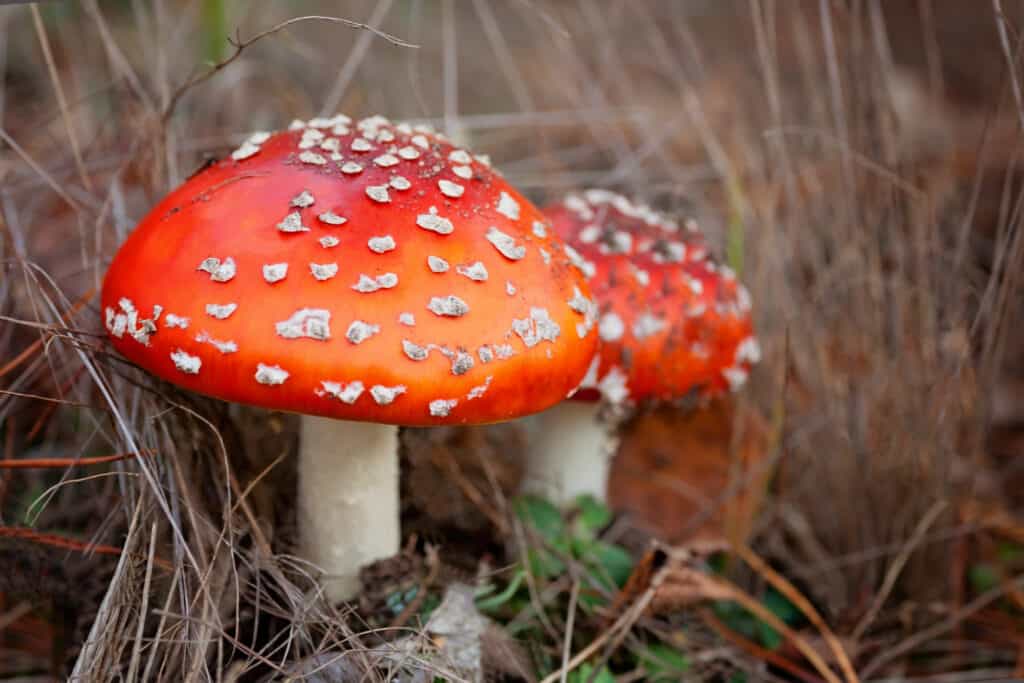
The Fly Agaric Mushroom is commonly used to represent mushrooms in cartoons and video games.
©iStock.com/aletheia97
If you think mushrooms only look similar to that happy little Amanita muscaria-like specimen in Super Mario, think again. Below, we’ll broadly and generally categorize some of the highly diverse mushroom “types” of the Basidiomycota and Ascomycota phyla of fungi based on their spore-dispersal tissue and shape. Please note that this type of categorizing does not reflect genetic relationship, but rather, provides a macroscopic morphology-based way to learn about the different types of mushrooms.
Gilled Mushrooms

Amanita phalloides aka death cap, a poisonous mushroom.
©el_cigarrito/Shutterstock.com
Often depicted as the quintessential mushroom, gilled mushrooms feature paper-thin, bladelike structures that attach to the underside of the cap. The thickness, spacing, color, depth, how they attach to the stipe, how far and if they run down the stipe, and their fragility can vary from species to species. Either side of a gill is covered in spore-producing cells. Gills are designed to optimize the number of spores that can be produced and dispersed at one time. Since they extend downward row after row, much more surface area can be covered in spores than if the spore dispersal tissue only consisted of a flat surface underneath the cap.
Thousands upon thousands of species share this spore-dispersal strategy. While some gilled mushrooms are related, having gills does not by any means signal one mushroom is related to another. Instead, the production of gills over and over again by non-closely related species is simply an evolutionary testament to how well this structure works as a spore-dispersal strategy. In other words, gills are an example of convergent evolution, or how unrelated organisms can independently evolve the same or similar structures in response to environmental pressures.
A few examples of gilled mushrooms we’ve previously covered include:
- Oyster mushrooms (Pleurotus spp.)
- Shiitake (Lentinula edodes)
- Honey mushrooms (Armillaria spp and Desarmillaria spp)
- Destroying angels (Amanita bisporigera, Amanita ocreata, Amanita virosa, and Amanita verna)
Types of Mushrooms: Pored Mushrooms
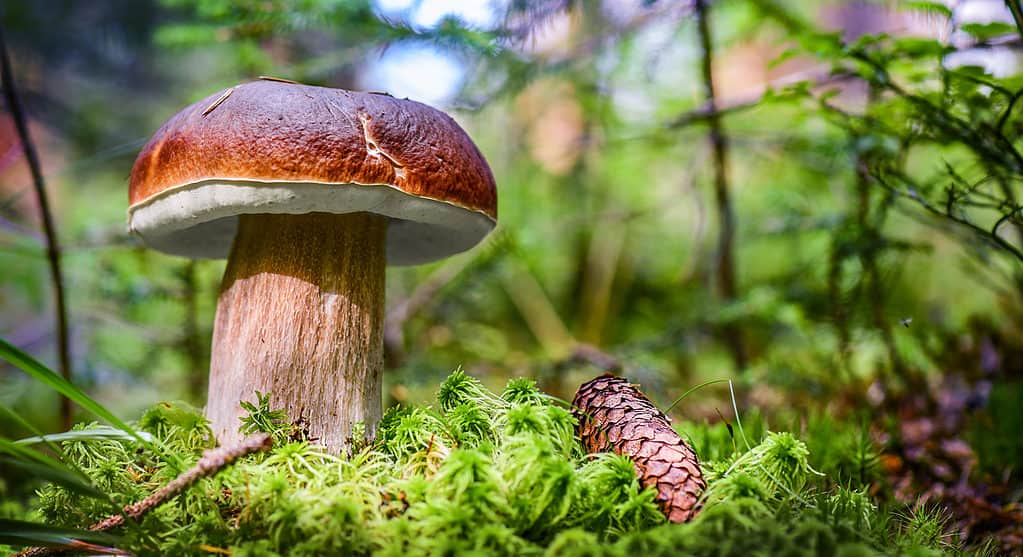
The King Bolete mushroom, Boletus edulis.
©Krasula/Shutterstock.com
Some mushrooms have developed tiny tube-like structures as their spore dispersal tissue. We call these structures pores. When you look at the underside of a pored mushroom and see tiny, often spongy, holes, these are the pores. Spore-producing cells line these tubes and send out spores when the mushroom is mature. Typically, mycologists separate pored mushrooms into two categories: boletes and polypores.
Boletes, of the Boletales order, constitute over 1,300 species across at least 15 families and 90 genera. The vast majority of boletes feature pores underneath the cap. A tiny percentage are the gilled boletes of the Phylloporus genus. Generally, boletes feature a distinctive umbrella-like spongy cap. Some species stain blue or red when sliced. Almost all boletes are mycorrhizal.
Polypores typically refer to pored shelf or bracket fungi that grow from wood. These mushrooms are often parasitic, saprobic, or a combination of the two. Like boletes, polypore mushrooms feature tube-like structures as their spore-dispersal tissue.
The size, texture, pattern, and density of pores on pored mushrooms can range widely.
Some examples of pored mushrooms that we’ve previously covered include:
- King bolete (Boletus edulis)
- Turkey tail mushrooms (Trametes versicolor)
- Reishi (Ganoderma lucidium)
- Boletes of the Suillus, Leccinum, and Tylopilus genera
Toothed Mushrooms
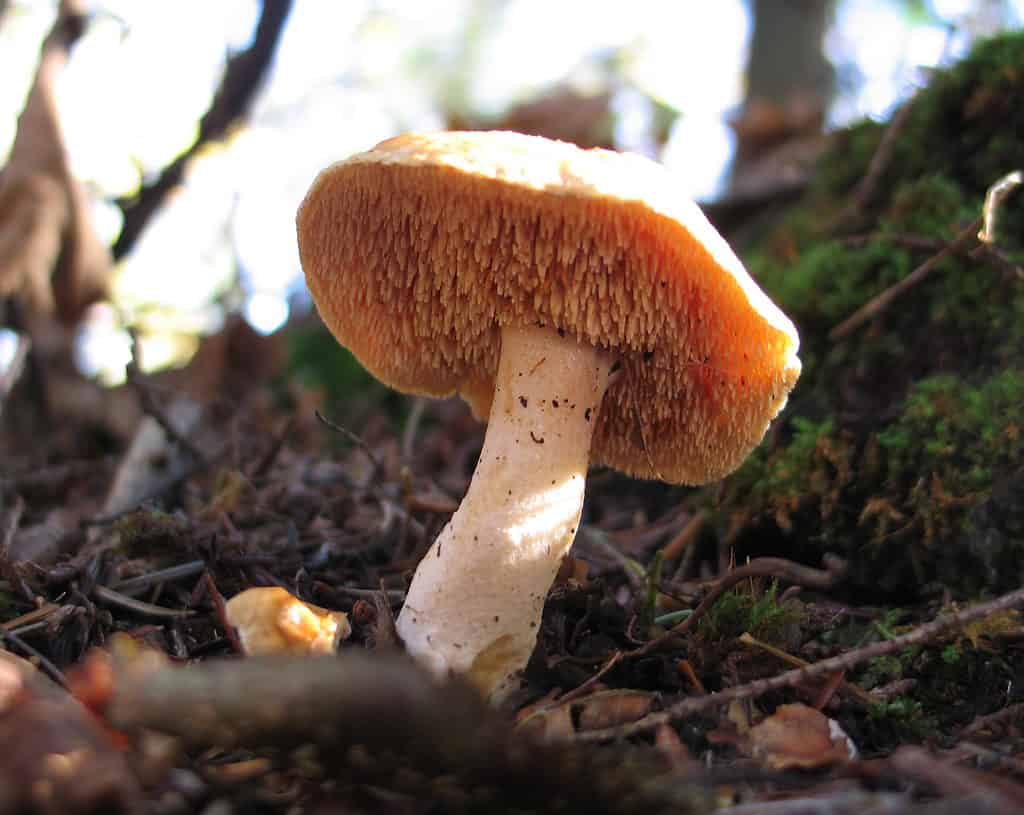
Hedgehog mushroom (Hydnum umbilicatum).
©Sandra Cohen-Rose and Colin Rose / Flickr – License
Less commonly, you may find mushrooms that feature spore-dispersal tissue resembling sharp teeth. Some also refer to these structures as spines. Depending on the species of mushrooms, these tooth-like structures can hang down a couple of millimeters to up to 2 inches. Like gills, spore-producing cells cover the teeth.
While toothed mushrooms are less common overall, you can find both stipe-and-cap and bracket/shelf mushrooms that feature them. It may be that, evolutionarily, gills are a more successful spore-dispersal strategy, thus accounting for the less commonly occurring toothed mushrooms.
However, there are a few well-known genera of mushrooms that feature toothed mushrooms. Previously, we’ve covered the following of such fungi:
- Hedgehog mushrooms (Hydnum spp.)
- Lion’s mane mushroom (Hericium erinaceus)
Types of Mushrooms: Clubs and Corals

Ophiocordyceps unilateralis is commonly called the zombie-ant fungus.
©David P. Hughes, Maj-Britt Pontoppidan/Wikimedia Commons – License
You can group club and coral mushrooms together due to their similar fruiting body shapes, rather than spore-dispersal structures. Note that in this context, club mushrooms refer to the actual mushroom shape, versus club fungi which is a term to describe all mushrooms of the Basidiomycota phylum that feature microscopic, spore-producing club-shaped structures called basidia. The club and coral mushrooms of this category also specifically refer to basidiomycetes within the Agaricomycete class and tend to exclude corals and club fungi with a gelatinous consistency.
Club mushrooms typically feature finger or club-like fruiting bodies that grow vertically. Depending on the species, you may find these mushrooms growing in groups, often from leaf litter across the forest floor or from the bodies of parasitized hosts. Check out our guide on an especially intriguing, parasitic species of club mushroom, Ophiocordyceps unilateralis.
Coral mushrooms are quite striking in that they really do resemble some species of marine coral. Hundreds of coral mushroom species across over 30 genera exist and represent a range of shapes and colors. These mushrooms can feature delicate, spindly, branching fruiting bodies or grow in wavy clusters resembling brain coral. If you’re interested in finding edible corals, Artomyces pyxidatus aka the “crown tipped coral” is a well known edible coral mushroom.
Types of Mushrooms: Gasteroids
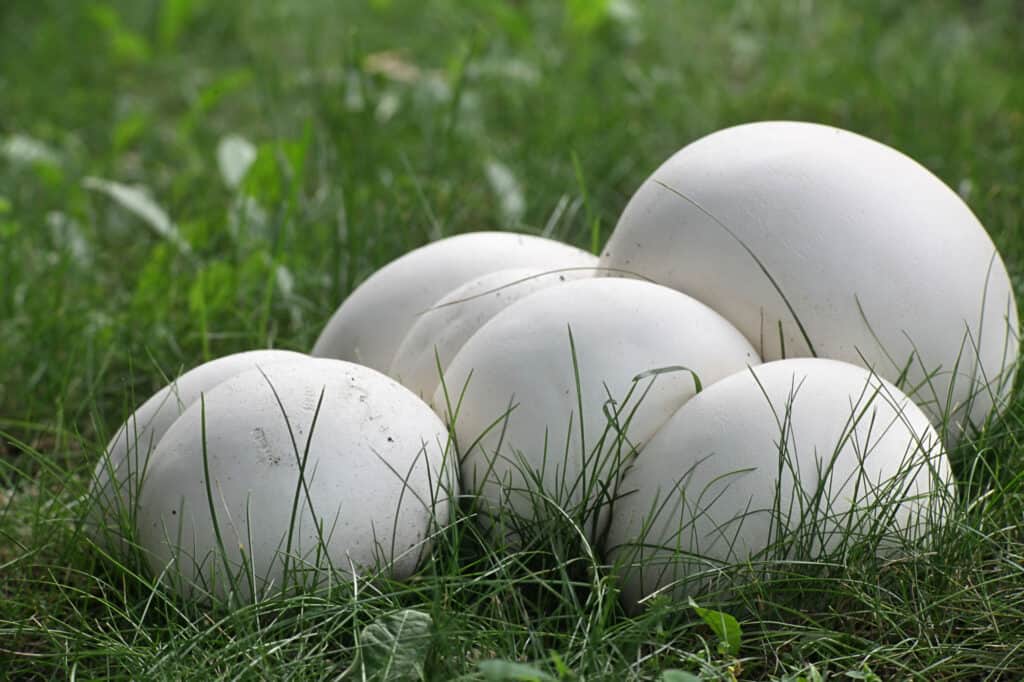
Giant puffball mushrooms.
©Henri Koskinen/Shutterstock.com
The spores of gasteroid mushrooms develop inside the fruiting body. This section contains some of the most expensive mushrooms in the world — truffles. Technically, some folks don’t consider hypogeous fruiting bodies, such as truffles, to be mushrooms, but it depends on the definition you use. This category also contains epigeous mushrooms such as puffballs, earthballs, and some of the most uniquely shaped and smelliest mushrooms in the world- stinkhorns.
Both Basidiomycota and Ascomycota are present in this category. Truffles belong to the Ascomycota phylum, while stinkhorns, false truffles, earthstars, puffballs, and earthballs belong to Basidiomycota. Gasteroid mushrooms use varying methods to disperse their spores such as stinkhorns developing a spore-filled liquid mass to be eaten by flies and puffballs sending bursts of spores into the air upon impact.
Some of the gasteroid mushrooms we’ve previously covered include:
- Giant puffball (Calvatia gigantea)
- Pecan truffle (Tuber lyonii)
- Stinkhorns of the Phallaceae family
Jelly Mushrooms of Basidiomycota
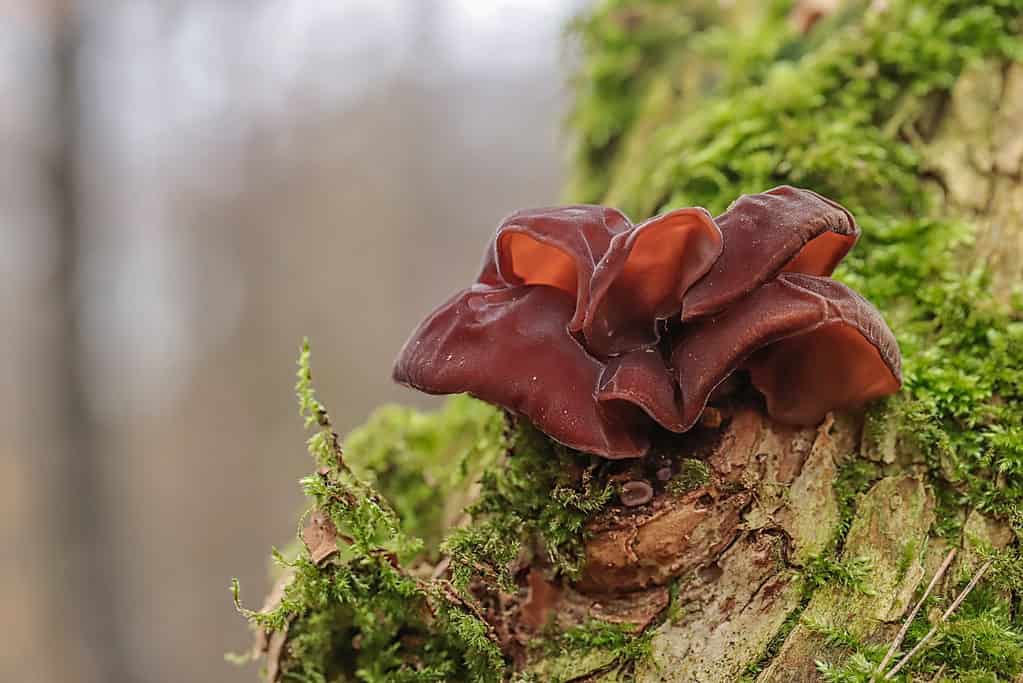
Auricularia sp. or wood ear mushroom growing on a piece of decaying wood
©Marek Mierzejewski/Shutterstock.com
As the name “jelly mushrooms” implies, this category consists of mushrooms in the Basidiomycota phylum with a jelly-like or gelatinous consistency. They come in a range of shapes and contain no noticeable spore-producing tissues. Instead, the spore-producing basidia line the gelatinous surface of these mushrooms. This category of jelly mushrooms excludes gelatinous ascomycete mushrooms. The jelly ear mushroom (Auricularia americana) is an example of a North American basidiomycete jelly mushroom.
Types of Mushrooms: Jellies of Ascomycota
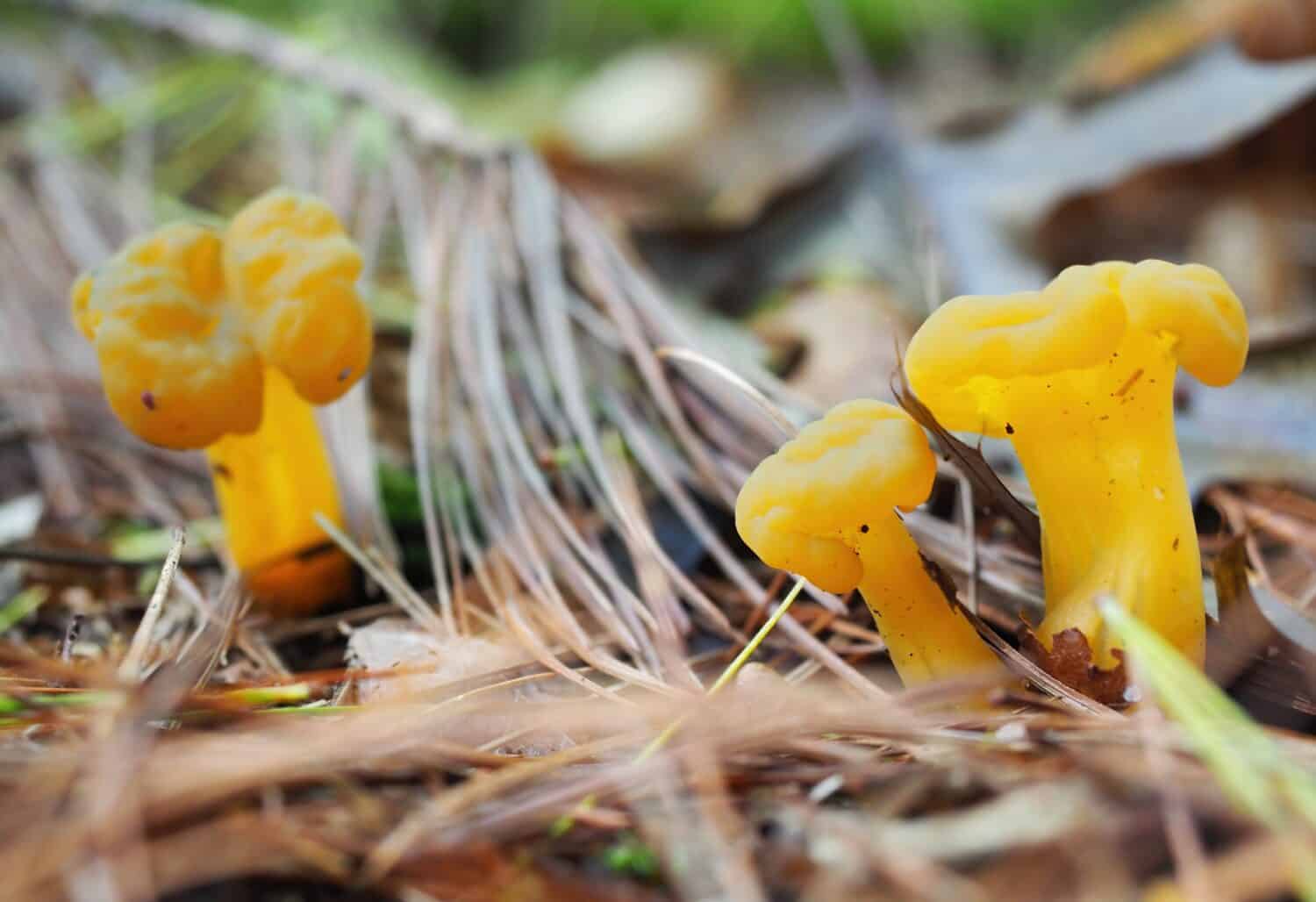
aka a “jelly baby”
©Maple Ferryman/Shutterstock.com
Like the jelly mushrooms of Basidiomycota, the ascomycete jelly mushrooms have a gelatinous consistency, though they tend to predominantly be cup, tube, or disc-shaped. Some of these mushrooms, such as the adorably named jelly babies (Leotia lubrica), have a cap-and-stipe appearance but do not contain visible spore-bearing tissue. The jelly drops or the purple jellydisc (Ascocoryne sarcoides) is another delightful example of an ascomycete jelly mushroom and features a wavy disc-like fruiting body.
Morels and Other Brain-Like Ascomycete Mushrooms

A beautiful morel
©AleksandarMilutinovic/Shutterstock.com
Our final category of this guide includes the highly sought-after morels of the Morchella genus and several other genera of stipe-and-cap Ascomycete mushrooms that feature a pitted, honey-comb, or brain-like cap. This category is largely typified based on these morphological features of the cap. Ironically, this popular and famous mushroom is not considered a mushroom by some definitions that say Ascomycete are not mushrooms. Some definitions also say only fungal fruiting bodies that are shaped like an umbrella are actually mushrooms.
The most familiar mushrooms of this category are certainly the prized morels, which feature oval or conical-shaped, pitted, and honey-comb patterned caps. The asci of morels are produced within the pits of the caps. Mushrooms that beginners may mistake for morels, such as those within the Gyromitra genus, fall into the category of containing brain-like caps. Unlike true morels, however, their caps don’t feature these honey-comb patterned pits.
The photo featured at the top of this post is © AleksandarMilutinovic/Shutterstock.com
The information presented on or through the Website is made available solely for general informational purposes. We do not warrant the accuracy, completeness, or usefulness of this information. Any reliance you place on such information is strictly at your own risk. We disclaim all liability and responsibility arising from any reliance placed on such materials by you or any other visitor to the Website, or by anyone who may be informed of any of its contents. None of the statements or claims on the Website should be taken as medical advice, health advice, or as confirmation that a plant, fungus, or other item is safe for consumption or will provide any health benefits. Anyone considering the health benefits of particular plant, fungus, or other item should first consult with a doctor or other medical professional. The statements made within this Website have not been evaluated by the Food and Drug Administration. These statements are not intended to diagnose, treat, cure or prevent any disease.
Thank you for reading! Have some feedback for us? Contact the AZ Animals editorial team.






